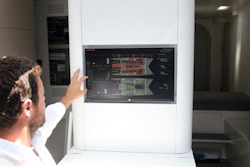The EMS: Energy management system
This is the brain of the vessel’s energy supply. Combining multiple intermittent renewable energy sources and storage is one thing. Optimising their use to propel the boat and ensure the crew’s comfort is another! This is where the Energy Management System (EMS) comes in. It is a set of automated machines which command and coordinate all the systems, and is driven by the human pilots using an on-board computer. Rockwell, American leader in industrial automation and partner in the Energy Observer project, contributed their experience and many software solutions.

Three main power modes are configured in the Energy Observer:
-In normal navigation, solar or wind electricity directly power propulsion.
-The lithium-ion batteries take over if there is a momentary drop in production, for example in cloudy weather.
– For longer interruptions, at night for example, the fuel cell takes over, and prolongs autonomy by converting hydrogen reserves into electricity.

Victorien in front of the EMS
On the other hand, strategies are also programmed to recharge batteries and resupply hydrogen stocks whenever possible, to ensure theses reserves are not depleted. For example, when battery life descends below 30%, the majority of the electricity production is used to recharge it. When battery life is over 90%, or the boat is stationary, the energy is used to restore the hydrogen reserves. The pilots can automatically vary the power of the motor, and hence the speed of the boat, to preserve stable charge levels.
All these decisions can now be managed almost instantly, either by the system, or by the pilots who can take over at any time. Thanks to dedicated software comprising 21 SFCs connected to 200 alarms, 12 analogue and 13 digital actuators, 1,050 elements of data can be uploaded by the internal digital network in real time.
Apart from ensuring comfortable navigation for the crew, this data is also a new knowledge base for developing routing software using renewable energy sources. And of course, this data can be recovered remotely for preventive maintenance of the whole system.
The team plans to still have one engineer on board in 2019, but one of the objectives at the end of the year will be to do without an engineer, so that any professional sailor can manage and navigate the boat autonomously. Given the performance, safety and low costs, it is an essential condition for the widespread use of hydrogen in maritime transport.
And this will give Energy Observer engineers time to develop other innovations… but that’s another story!